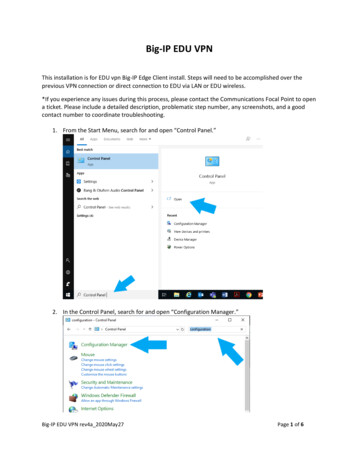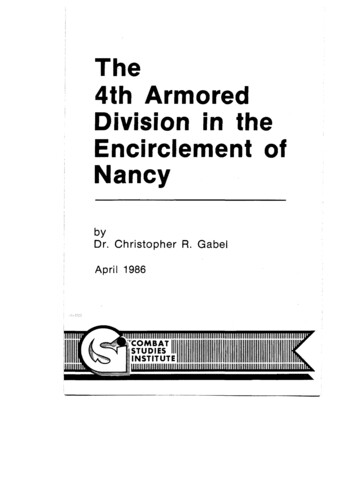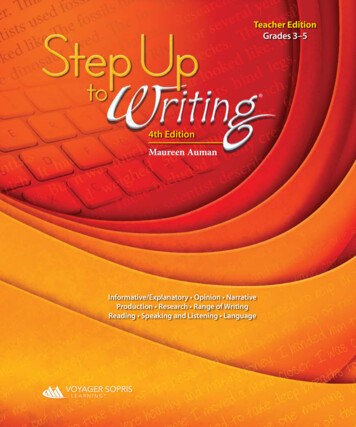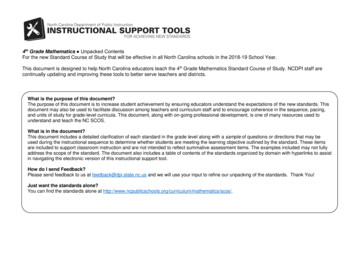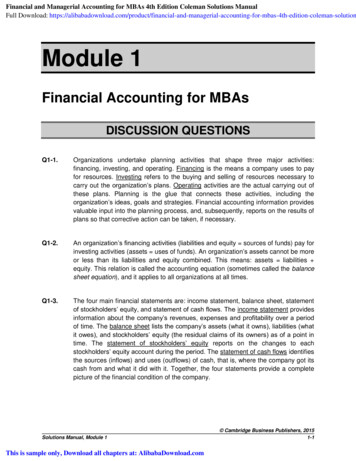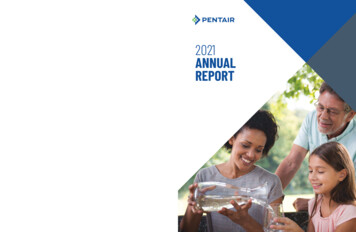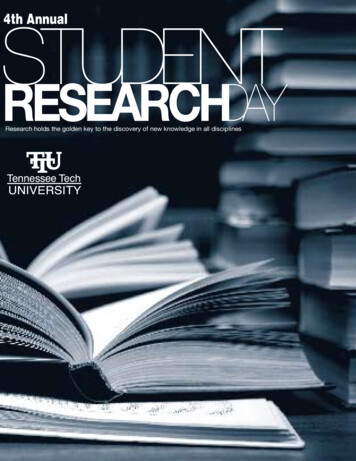
Transcription
4th AnnualResearch holds the golden key to the discovery of new knowledge in all disciplines
Table of Contents Research Day Purpose.2 Schedule of Events.2 A Message from the President.3 A Message from the Provost.4 A Message from the Associate Vice President for Research.4 Acknowledgements.5 Student Abstracts. 6-40 Agricultural and Human Sciences .6-7Agriculture.6Human Ecology.6-7 Arts and Sciences. 7-15Chemistry. 7-12Computer Science. 12-13Earth Sciences. 13-15Physics. 15-16 Education. 15-16Counseling and Psychology. 15-16Curriculum and Instruction.16Exceptional Learning.16 Engineering. 17-40Chemical Engineering.17-27Civil and Environmental Engineering.27-30Electrical and Computer Engineering.30-39Manufacturing and Industrial Engineering. 39Mechanical Engineering.39-40 Directory of Participants.41 tennessee technological university
Research Day - PurposeStudent Research Day at Tennessee Technological University is an eventDESIGNED TO SHOWCASE in a poster format the research and otherscholarly activities of undergraduate and graduate students.Schedule of EventsStudent Research DayRoaden University CenterMultipurpose RoomTuesday, March 31, 20097:00 a.m. – 8:00 a.m.Poster Set-up8:00 a.m. – 9:30 a.m.JudgingStudents at posters (if possible)10:00 a.m. – 11:15 a.m. Open Poster Review and DiscussionStudents at posters (if possible)11:15 a.m. – noonAwards CeremonyNoon- 2:00 p.m.Open Poster Review and DiscussionStudents at posters (if possible)2:00 p.m. – 3:00 p.m.Poster pick-upRefreshments will be served throughout the day. tennessee technological university
March 31, 2009Dear Student Investigators:Congratulations on the outstanding display of investigative research! On behalf of the students, faculty and staff at Tennessee Technological University, I commend you for your research accomplishedunder the guidance of faculty research advisors. Your participation in Student Research Day bringshonor and recognition to yourself, the University, the greater community and to the State. We thankyou for sharing your research efforts.Research is central in University training. Your research displayed today showcases Tennessee Technological University’s being named, for five consecutive years, one of the Best Southeastern Collegesby the Princeton Review. U.S. News and World Report ranks Tennessee Tech University in the Top TenPublic Universities in the South – Master’s category rankings.Thank you for participating in Student Research Day!Sincerely,Robert R. BellPresident tennessee technological university
Dear Tennessee Tech students:TTU is strongly committed to active forms of learning, and student research, atboth the graduate and undergraduate levels, has become one of the key forms.Research not only enhances the acquisition of knowledge but also provideschallenging opportunities to improve communication skills as the researchertransmits results through exhibits, presentations, and verbal interaction.I’m delighted to welcome everyone to Student Research Day 2009, a time forcelebrating our commitment to active learning and for showcasing the work ofsome of our best students.Sincerely,Jack ArmisteadProvost and Vice President for Academic AffairsWELCOME TO TENNESSEE TECH RESEARCH DAYIt is with great pleasure that we welcome you to the Student Research Day Poster Session. We take this opportunity to give you a glimpse of the research activities involvingundergraduate and graduate students that take place in the different departments atTennessee Tech.Students’ participation in research is consistent with our commitment to the life-longsuccess of our students. Research stimulates active learning, increases critical thinkingskills and effectively prepares our students for the workforce of the 21st century. It isthrough research that new knowledge is created and disseminated, and technology isdeveloped and transferred to benefit society.We express our appreciation to the students who have prepared and presented theirposters, the faculty advisors who have guided and/or supervised the projects, and theResearch Liaison Officers who have assisted us in planning and encouraging participation in the Student Research Day Poster Session. We are pleased by the opportunityprovided by the Student Research Day for students to showcase their creative endeavors.We hope that the projects would stimulate more interest in student research and otherscholarly activities that enhance teaching and learning.Thank you.Francis OtuonyeAssociate Vice PresidentResearch and Graduate Studies tennessee technological university
AcknowledgementsACKNOWLEDGEMENTSThe Research Day Committee gratefully acknowledges everyone who contributed in any way to the success of Student Research Day 2008. Theday’s activities are designed to showcase student research and the great deal of activity that is currently underway on campus. A total of 108abstracts involving 114 undergraduate and graduate students, more than 40 faculty advisors, and various collaborators both inside and outsideTTU were received for presentation this year from a number of departments across campus.The event would not be possible were it not for the collective energies, dedication, and initiative of MANY individuals, departments, and othergroups across campus. Of particular note, thank you to Monica Greppin in Public Affairs for her guidance and assistance with advertising theevent; to Dewayne Wright for coordination of publication activities and to James Mabery and Lorie Worley for the design and preparation ofthis booklet and cover. Also, we wish to thank Dean Carothers in Photo Services for preparing the display boards and for his assistance withphotographing the day’s events. Thank you to Printing Services for timely printing of this booklet. The Committee further recognizes theUniversity Bookstore and University Dining Services for the role that each has played with this activity.We extend sincere thanks and appreciation to Dr. Allen Atkins and Boeing Corporation for monetary awards for the best posters and also to Davidand Sherri Nichols for their endowment to support Student Research Day activities.The bronze medallions that will be provided for the best posters were designed and manufactured as part of a senior research project by students(Jacob Burkey, Stephen Gallagher, Stephen Goodman, and Christopher Nabors) in Dr. Ahmed ElSawy’s Manufacturing and Industrial Technologyclass. We are extremely grateful to them for the significant contributions that they all made and to the TTU Chapter of the Sigma Xi ScientificResearch Society for co-sponsoring this activity.We would also like to thank President Bell and Provost Armistead for their support of this event. Faculty, department chairs, college deans, andcenter directors all provided valuable contributions to ensure the success of the day’s events. A special thanks is extended to Mark Lynam, KathyReynolds, Sammie Sparks, and Ellen Wolfe in the Office of Research for excellent assistance and services provided in making this event a reality.To all who helped in any way listed or not, THANK YOU VERY MUCH!Most sincerely,The Research Day CommitteeDr. Pat BagleyDr. Subramaniam DeivanayagamDr. Virginia MooreDr. Paul SemmesDr. John WheelerDr. Robby SandersDr. Francis Otuonye tennessee technological university
Agriculture & Human EcologyCollege of agricultural & Human SciencesAGRICULTUREUNDERGRADUATE STUDENTSWATER HOLDING CAPACITY AS INFLUENCEDBY ADDITIONS OF COMPOSTNicholas MooneyhamAgricultureFaculty Research Advisor: Dr. Janice BransonWater holding capacity in soil is an indication of how aparticular soil will act under a given set of circumstances.The objective of this study was to determine if there werenoticeable differences in water holding capacity of testplots treated with varying amounts of organic compost.Sampling included two replications of each treatment (0 lbsof compost, 22 lbs of compost, 66 lbs of compost, and 110lbs of compost). Samples were analyzed for organic carboncontent, bulk density, and gravimetric moisture. Bulk densityin all composted plots was reduced by organic matteradditions. While field capacity and saturation measurementsreflected a definite influence from organic matter content inthe south end of the field, soil inconsistency at the north endresulted in a high amount of variability in those plots.THE EFFECT OF COMPOST APPLICATIONSON EARTHWORM POPULATIONSROOT YIELDS INCOMPOSTED TOMATO BEDSLance YatesAgricultureFaculty Research Advisor: Dr. Janice BransonOrganic compost improves soil quality resulting in greaterconcentrations of root material. High levels of organic matterin soil improve permeability, water holding capacity, andbulk density. The objective of this study was to determinethe concentration of roots in seven plots with differentamounts of compost applied to each plot. An 18” x 18” x 6”sample was removed from each plot using a sod cuttingshovel. Soil was separated from roots with a 2 mm sieveand the roots then washed. Roots were sorted by size (veryfine, fine, medium, coarse, and very coarse) and weighed.Results showed sample 89-T-3 receiving 66 lbs. of compostper plot had the greatest concentration of root materialpresent. Samples with concentrations of 110 lbs. showed asignificantly lower amount of root material in comparison.Plots receiving 0 or 22 lbs. of compost varied greatly in rootconcentration.HUMAN ECOLOGYUNDERGRADUATE STUDENTSCURRENT RESEARCH ON THYROID DISEASEAurora ScottAgricultureFaculty Research Advisor: Dr. Janice BransonCrystal JohnsonHuman EcologyFaculty Research Advisor: Dr. Melinda AndersonAristotle once referred to earthworms as “the intestinesof the Earth”. Earthworms are a critical componentdecomposition of organic materials in the soil ecosystem.The objective of this study was to determine if varyingrates of compost resulted in a corresponding increase inearthworm population. At the TTU Water’s Farm, eight18”x18”x 6” soil samples (two replications) were taken fromtomato plots. Each plot had received one of the followingtreatments: 0 lbs, 22 lbs, 66 lbs, or 110 lbs of compost.All soil in the samples was sifted with a 2 mm sieve.Earthworms were extracted during the sieving process.Plots containing 0 compost contained 43 earthworms,populations in plots with 22 pounds of compost increasedby 121% (95 earthworms), populations in plots with 66pounds of compost increased by 86% (80 earthworms), andpopulations in plots with 110 pounds of compost increasedby 63% (70 earthworms). While there was a definite increasein populations in plots receiving additional food material,the higher rates of compost additions did not result is acorresponding increase in earthworm population. Therefore,additional compost would have limited results concerningearthworm population.The purpose of this current research project is to providegeneral information concerning the thyroid glands as wellas the hormones/functions, problems/disorders, deficienciesand symptoms/treatments of the glands. The endocrinesystem consists of eight main endocrine glands that secretehormones. Specifically, the thyroid gland, its hormones/functions, problems/disorders, deficiencies and symptoms/treatments will be covered. Simply, the thyroid hormones,T3 and T4, regulate metabolism. Some problems anddisorders associated with the thyroid are hypothyroidism,Hashimoto’s thyroiditis, hyperthyroidism and Grave’s disease.Hypothyroidism is a result of an under-active thyroid glandnot producing enough thyroid hormone. Hyperthyroidismoccurs from an overactive thyroid gland that produces toomuch of the thyroid hormone. Some symptoms associatedwith hypothyroidism are fatigue, weight gain and feelingcold. A few symptoms of hyperthyroidism are weightloss, diarrhea and even infertility. Treatments vary amongeach disorder. One deficiency linked to the thyroid glandis goiter, which is merely an enlarged thyroid gland thatphysically proves the thyroid is growing abnormally. Properfunctioning of the thyroid gland is crucial to ones health andplays a vital role in the body. tennessee technological university
College of Arts and SciencesFelicia ShoultaHuman EcologyFaculty Research Advisor: Dr. Melinda AndersonAccording to the American Diabetes Association 17.5million Americans have diabetes. Along with diabetes alsocome serious complications. Diabetes and diabetes-relatedcomplications account for more than 174 billion dollars inhealthcare costs each year! Two types of diabetes exist. Typeone is also known as insulin-dependent diabetes mellituswhich means that the pancreas no longer produces insulin.It usually occurs in children and adolescents. It is unknownwhat causes type one, but it may be linked to genetics. Typetwo diabetes is the most common type and usually occursin older adults (recently many children are diagnosed dueto obesity). Heart disease, kidney disease, eye problems,and nerve damage are just a few of the complicationsthat can occur due to uncontrolled diabetes. The goalsof treating diabetes is getting blood glucose as close tonormal as possible and to prevent future complications.The Diabetes Control and Complications Trial (1983-1993)studied how well intensive therapy reduced diabetes-relatedcomplications. Intensive therapy consisted of 3-4 injectionsof insulin a day, individual consultation, frequent bloodglucose tests, and a goal of close to normal blood glucoselevels. Intensive therapy appeared, and continues, to be thebest at controlling diabetes and preventing complications.THE EFFECT OF WHOLE WHEAT FLOURON BANANA MUFFIN QUALITYMary Walker Watson and David KnielingHuman EcologyFaculty Research Advisor: Dr. Cathy CunninghamThe purpose of this experiment was to measure the effect ofwhole wheat flour on taste and nutrient content of bananamuffins. Increasing consumption of whole grains has apositive effect on health. The banana muffins were made inthree treatments varying the ratios of all-purpose and wholewheat flour (66%:33%, 50%:50%, 33%:66%). Banana muffinswere evaluated by ten panelists for internal air cell size,internal color, flavor, moistness, and overall acceptability.Internal color and internal air cell size scores were moresignificantly different than moistness and taste scores. Twotrained food scientists found no difference when evaluatingthe appearance of the internal crumb. Each muffin treatmentwas measured objectively for height, weight, nutrients andcost. There was no significant difference in height, weight orcost of the banana muffins.CHEMISTRYGRADUATE STUDENTSASSEMBLING A FLOW-CELL FLUORESCENCESENSOR FOR COPPER, ZINC ANDALUMINIUM USING POLYMER MEMBRANEHenry Abougor, Sarah Brinkley, John Patridge, Matt Mancusoand Roshan FernandoChemistryFaculty Research Advisor: Dr. Andrew F. CallenderThe rising problem of pollution in our environment hasprompted the need for sensitive device, able to detecttrace amount of metal ions in the environment. We havedeveloped a compact, portable fluorescence sensor forrapid screening of metal ions in polluted waters. The sensorconsists of am ion-selective fluorescent membrane in a flowcell. A blue Led excites fluorescence from the membrane.Metal ions in the water flowing through the cell quenchthe fluorescence. The metals detected depend on themembrane composition. The flow cell is designed to betaken apart easily and the membrane replaced to detectother metals. The three colour photodiode allows detectionof the fluorescence emitted at different wavelengths. Ourinstrument uses readily-available parts to reduce cost,allowing multiple instruments for rapid screening acrossa large area.The ion-selective fluorophores are Morin (2,3,4,5,7 –pentahydroxy flavone, responds to AL(111) andtetraphenenylporporphyrin (responds to Zn(11). We reportthe sensitivity and selectivity of the instrument for thesetwo metals. It is recommended that the device be adaptedfor use in pre-investigation of pollutions because the deviceis not limited to a particular membrane this allow for morefluorophore to be used, more so the wavelengths can beselectively filtered to suit its purpose.Human ecology & ChemistryDIABETES AND INTENSIVE THERAPYCLASSIFICATION OF APPLE VARIETIESON THE BASIS OF VOLITILE ORGANICSBY SPME-GC-MSAmanda J. Crook, Archana Tirmula, and Keyuri PatelChemistryFaculty Research Advisor: Dr. Andrew CallendarVarious apple samples were analyzed for volatile organiccomponents through solid-phase micro extraction gaschromatography mass spectrometry (SPME-GC-MS) toclassify apple varieties. Samples were obtained from fivedifferent apple varieties commonly available in stores.Samples of apple flesh were obtained using a cork borer toensure uniform size, shape and surface area. The SPME fiberinjection technique was used to adsorb the volatile organiccompounds (VOCs), which provide the distinctions between tennessee technological university
ChemistryCollege of ARTS AND SCIENCEsflavors of apple varieties. SPME-GC-MS allowed only theVOCs of interest to be considered in this analysis, insteadof the water, sugars, and other components of the apples.Variations in the VOCs upon oxidation were also observedto determine the effects of browning on apples. Principalcomponents analysis (PCA) and a classification scheme wereapplied to the SPME-GC-MS data. Multiple classificationschemes were tested and compared to determine thebest method for classification. The application of PCA andthe chosen classification scheme allowed the identities ofunknown apples to be determined.PHYTOREMEDIATION OF PHARMACEUTICALSIN WATER USING DUCKWEED,BULRUSH AND PLANKTONIC ALGAEUpul DeepthikeChemistryFaculty Research Advisors: Dr. Jeffrey BolesCollaborator: Dr. Martha Wells, Center for the Management,Utilization and Protection of Water ResourcesThe occurrence of pharmaceuticals in water bodies is anemerging environmental concern. Even though the chroniceffects of low-level exposure of these pharmaceuticals arenot well-documented, s biologically active compoundsthey are potentially capable of interfereing with biologicalsystems. In this research, the potential was assessedof using duckweed, bulrush and planktonic algae inpghytoremediation of several pharmaceuticals which areconsidered among the most harmful pharmaceuticals toaquatic environments In addition, the accumulation ofthose pharmaceuticals in leaf and root parts of duckweedwa investigated. A combination of ultra hight performanceliquird chromatography and ttime-of-flight massspectrometry (UPLC-QTOF), which provides the capabilityof fast and highly sensitive detection, were employed in theanalysis.THEORETICAL STUDIESON QUINONE REACTIVITYRoshan FernandoChemistryFaculty Research Advisor: Dr. Titus Albu Quinones are a class of naturally occurring compoundsthat are biologically very relevant due to their ability toparticipate in redox couples. They act as electron carriersin the mitochondrion and act as electron acceptors inphotosynthesis in both bacterial and higher plants. Atheoretical study of a series of four benzoquinones (parabenzoquinone, ortho-benzoquinone, 2-chloro-parabenzoquinone, and 2-methyl-para-benzoquinone) wascarried out using the mPWB95-44 density functional theorytennessee technological universitywith the 6-31 G(d,p) basis set. One aspect of this studyis focused in calculating redox potentials, and we identifynine relevant redox reactions. The reversible potentialsof all nine reactions and for all benzoquinone derivativeswere determined, both in gas phase and aqueous phase.The results obtained are in very good agreement withexperimental and previously published data. Anotheraspect of the study is investigating the reactivity towardN-containing nucleophiles such as NH3, NH2CH3, andNHC2H5. Transition states are investigating for the hydrogenabstraction process involve in the reactions. Also we areinvestigating the reactivity of quinones with lysine (anamino acid). The study will be later extended to otherquinones and some other nucleophiles.MODIFIED SOLVENT SYSTEM FOR THESIMULTANEOUS SOLVENT EXTRACTIONOF CESIUM AND STRONTIUMJohn PartridgeChemistryFaculty Research Advisor: Dr. Dale EnsorCollaborators: Laetita Delmau, Bruce A. Moyer,and Dean PetermanThe effective simultaneous extraction of cesium andstrontium from high level nuclear waste has receivedrenewed interest as a result of the proposed recycling ofcivilian nuclear fuel. Removal of the radionuclides of cesiumand strontium, which initially account for the majority ofradioactivity and heat production, from the waste woulddrastically reduce the amount of waste requiring longterm geologic storage, as well as reduce costs of building arecycling facility. The extraction characteristics of 137Cs and85Sr were studied using a variety of modifiers in the solvent.The effects of various solvent modifiers were measured as afunction of concentrations of extractants, aqueous acidity,and third phase formation. Experimental results indicatethat a viable simultaneous extraction system for cesium andstrontium from highly acidic waste can be developed.THEORETICAL MODELING OF ELECTRONTRANSFER BETWEEN CYTOCHROME CAND TRANSITION METAL COMPLEXESThusitha PathirathneChemistryFaculty Research Advisor: Dr. Scott H. NorthrupElectrostatic interactions have been identified as a keyphenomenon that facilitates electron transfer reactionsbetween proteins and their redox partners. Therefore, anaccurate description of the electrostatic fields around aprotein and its redox partner at various pH levels and saltconcentrations is essential to analyze specific interactions
College of Arts and SciencesCHEMISTRYUNDERGRADUATE STUDENTSSYNTHESIS AND CHARACTERIZATIONOF NEW ACETYLPYRAZINETHIOSEMICARBAZONESMichael Beck** and Keith SteelmanChemistryFaculty Research Advisor: Dr. Edward C. LisicSeveral new acetylpyrazine semicarbazone andthiosemicarbazone derivatives have been synthesizedand characterized by melting point analysis, 1H NMRspectrometry and IR spectroscopy. These new compoundsmay have uses in medicinal chemistry, and will serve asligands for the purpose of forming complexes with transitionmetals ions such as Cu(II) and Pd(II).CHEMICAL FINGERPRINTINGOF CLANDESTINE METHAMPHETAMINEBY GC/MS/MS & LC/MS/MSTO ESTABLISH METH INDEXSarah C. Brinkley and Sri Bharat MadireddyChemistryFaculty Research Advisor: Dr. Jeffrey O. BolesMethamphetamine (N-methyl-1-phenylpropan-2-amine), apotent psycho-stimulant, has been a major cause of concernthroughout the world, especially in the State of Tennessee.1Illicit manufacture of methamphetamine in clandestinelaboratories has been carried out with the minimal use ofeasily obtainable over-the-counter ingredients.1 Currently,local law enforcement agencies lack the resources necessaryto perform timely and cost effective investigation ofmeth-related crimes. However, research is currently beingconducted to positively identify the ‘chemical fingerprint’of seized clandestine methamphetamine; establishinga nationwide database containing such informationwould feasibly remedy this issue. This research focuseson developing an impurity profile for methamphetamineby LC/MS/MS; further supported by, both, qualitative andquantitative GC/MS/MS techniques. Selecting for specificmarkers - namely, ephedrine and benzylmethylketone(synthetic precursors), N-formylmethamphetamine(synthetic intermediate), and Caffeine (adulterant) - allowssuch a fingerprint to be constructed. An easily accessibledirectory, or METH INDEX, of confiscated methamphetaminebecomes invaluable to officers of the law. The informationthis data-set provides will potentially create a uniqueadvantage to criminal investigation, in that 1) drug-relatedcrimes can be linked to clandestine chemists, providingthe opportunity for more lengthy incarceration and 2) themethods utilized to synthesize methamphetamine, whichevolve with the increasing restriction of starting materials,can be more rapidly determined.chemistryat the molecular level. The Poisson-Boltzmann equationhas been widely used in conjunction with Browniandynamics simulations to calculate diffusional associationrate constants for electron transfer between redox partners.Previous work at TTU has correctly described proteinelectron transfer processes in terms of qualitative trendsusing this method, but has failed to provide a quantitativelyaccurate treatment of the ionic strength effects on thebimolecular rate constants. Taking this into account, inthis work we enhanced the existing Brownian dynamicsmethodology developed extensively by Northrup and coworkers and the enhanced model is proved to be morerobust as it models the electrostatic fields more accuratelyat various ionic strengths. Using the enhanced Browniandynamics methodology we were able to quantitativelymodel the bimolecular kinetics of electron transfer betweencytochrome c and seven different transition metal ioncomplexes, and extract intrinsic rate parameters governingthe electron transfer event.References1. United Nations, New York, Recommended methodsfor the identification and analysis of amphetamine,methamphetamine and their ring-substitutedanalogues in seized materials. ST/NAR/34 (2006)2. C. J. Koester, B. D. Andresen, P. M. Grant, Optimummethamphetamine profiling with sample preparationby Solid-Phase Micro extraction. J. Forensic Sci. 47(2002) 1002-1007ANALYSIS OF PRODUCT INHIBITION,STABILITY, AND CATION ACTIVATIONOF ASPERGILLUS NIGER CELLULASEFrank B. Couch, IVChemistryFaculty Research Advisor: Dr. Jeffrey O. BolesOur dependency on foreign oil can be reduced throughthe utilization of alternative fuels, such as cellulosicethanol, which would also provide a fuel source moreenvironmentally friendly than fossil fuels. The commercialavailability of cellulosic ethanol is hampered at this time bythe slow hydrolysis of cellulose. This project investigated1) whether or not cellulase from A. niger suffers feedback(product) inhibition, 2) the stability of A. niger cellulaseunder varying temperature conditions, and 3) the effect ofmetal cations such as Na , K , Ca , and Mg on specificactivity. Feedback (product) inhibition was tested for byadding product (glucose) directly to the assay tubes. For 1, 2,and 5 µmol of glucose added, A. niger cellulase did not show tennessee technological university
ChemistryCollege of ARTS AND SCIENCEsinhibition. Temperature stability was tested by incubatingcellulase stock solutions for 24 hours at 50, 55, 60, 65, or70 C. A. niger cellulase showed a high degree of stabilityfor 50, 55, and 60 C, but rapidly lost activity at highertemperatures. Metal cations were added to the reactionmixture in various concentrations and the specific activitymeasured. Of the aforementioned ions, only Mg showedpromise as an activator, while the others showed decreasedactivity or little change.THE PREPARATION OF 1-METHYL-3OCTYLIMIDAZOLIUM CHLORIDE FOR USE ASA GREEN CHEMISTRY RE
According to the American Diabetes Association 17.5 million Americans have diabetes. Along with diabetes also come serious complications. Diabetes and diabetes-related complications account for more than 174 billion dollars in healthcare costs each year! Two types of diabetes exist. Type one is also know
